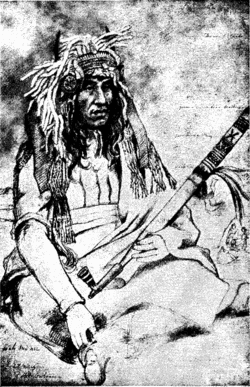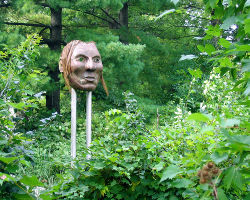Little Crow
A key figure in the first years of Minnesota’s statehood, Little Crow (or Taoyateduta) (ca. 1810 - 1863) is best known for his role in the Dakota Conflict of 1862. Little Crow was a strong leader of the Mdewakanton Dakota people, though he also met with significant internal dissent and opposition. He acted as both diplomat in Washington and leader of the uprising against the state. As a leader, he valued the indigenous cultures that were subverted by the expanding United States but also believed in the necessity of adapting to the expanding state.
Childhood
Little Crow was born in about 1810 into a long line of hereditary chiefs of the Mdewakanton village of Kaposia. The name "Little Crow" came from white traders, who had used the same name for several of his forebears. Among his own people, Little Crow was called "Taoyateduta" or "His Red Nation," a name that he chose for himself as a part of his preparations for the responsibilities that he would have as an adult.
Little Crow the chief
Taoyateduta rose to a powerful position within his village early in adulthood and continued to exert a great deal of influence within the Mdewakanton tribe throughout much of his life. Upon his father's accidental death in October of 1845 from a gunshot wound to the chest, Little Crow was in line to become the chief of his village. However, Little Crow was away from the village at the time of his father's death, had been away frequently during his childhood, and as Anderson notes, “had a bad reputation to overcome” [1] Leadership passed to his half brother.
The ambitious Little Crow started planning his return immediately, however, and appeared in Kaposia in the spring of the following year. The new chief and a second of Little Crow's half brothers had declared that he was no longer welcome in the village and confronted him with weapons in hand. A short confrontation ended with a gunshot that broke the bones in both of Little Crow's forearms. His half-brothers fled and Taoyateduta was rushed to Fort Snelling, where the surgeon recommended the amputation of both of his hands. Little Crow returned to Kaposia to seek the aid of the Dakota shamans and quickly garnered the support of the village elders, though his arms remained deformed for the rest of his life.
With the support of the elders, Little Crow had his half brothers executed and installed himself as the rightful chief of Kaposia. Drawing on his position, his skills as an orator, his close relationships with many in the White community his extensive kinship network, Little Crow began his ascendancy toward the position of speaker of the tribe.
Little Crow the diplomat
Taoyateduta first represented his people in negotiations with agents of the United States in 1851.
The Dakota Conflict
Flight to Canada and death
Legacy
Notes
- ↑ Gary Clayton Anderson. 1986 Little Crow, spokesman for the Sioux. Saint Paul: Minnesota Historical Society Press. ISBN 0-87351-196-4

